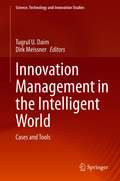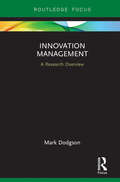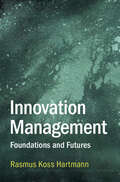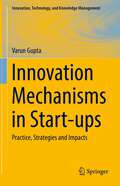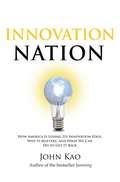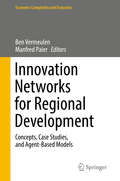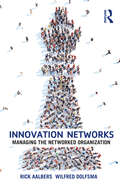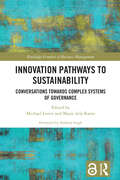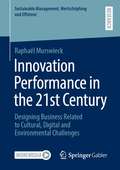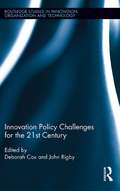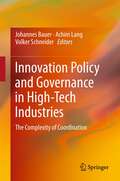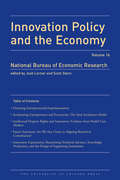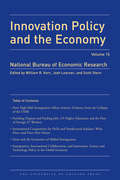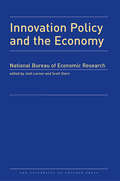- Table View
- List View
Innovation Management in Robot Society (Routledge Studies in Technology, Work and Organizations)
by Kristian WasénThis book introduces cutting-edge issues and thought-provoking concepts on innovation management. It illustrates how robotic developments allow new powerful support functionalities for harnessing workplace innovations and new types of work in enterprises. In particular, low status jobs—heavy, repetitive and dangerous jobs—are disappearing and increasingly replaced by creative and meaningful work. It situates the research within theoretical developments and academic literature in business and management studies on innovation networks and partnerships. The book then introduces the notion of "friction management," which invites us to re-examine creative tensions and explore how contradictions may spur or restrain change and innovation in this landscape. Innovation and change challenge established patterns, cultures, value systems, interests and network configurations—which creates a variety of frictions. Therefore, a theory of friction management is crucial, particularly in innovation-intensive industries, and can help professionals to understand change and the dynamics of innovation so that they can orchestrate events and learn to distinguish between the creative and negative frictions that can arise and that are important for change and the innovation process. Thus, the goal of friction management is to orchestrate, mobilize and (re)combine key organizational resources to strategically increase innovation capacity and promote dynamic renewal and creativity. It will be of interest to scholars and postgraduates in the areas of innovation management, sociology and business administration.
Innovation Management in the Intelligent World: Cases and Tools (Science, Technology and Innovation Studies)
by Dirk Meissner Tugrul U. DaimThis book introduces readers to state-of-the-art cases and tools for managing innovation in today’s rapidly changing business environment. It provides a wealth of methodological knowhow and guidance on practical applications, as well as case studies that reveal various challenges in technology and innovation management. Written by a mix of academic scholars and practitioners, the respective chapters present tools and approaches for the early detection of emerging fields of innovation, as well as relevant processes and resources. The contributing authors hail from leading innovative companies including Google, Amazon, Intel, Daimler-Benz, and NASA.
Innovation Management: A Research Overview (State of the Art in Business Research)
by Mark DodgsonInnovation is the means by which organizations survive and thrive in uncertain and turbulent conditions. Innovation management has become a well-established field of research, teaching and practice, with a substantial literature. As a broad-based research field, contributions stem from an array of perspectives including science, economics, engineering and psychology. Innovation is crucial for economic and social progress, and it needs to be managed in order to be beneficial. Innovation Management: A Research Overview provides a concise introduction to the best research on innovation management. It covers four main themes: foundational studies, key concepts and frameworks, important empirical studies, and current and emerging themes. The research discussed includes classic studies, with core insights in the field, key thinking on strategies and processes for innovation, well-established and novel research methods, and issues of greatest contemporary importance. This shortform book provides direction through the maze of research on the nature, processes and outcomes of innovation management, and provides an invaluable introduction to the literature on innovation management for students and professionals.
Innovation Management: Foundations and Futures
by Rasmus Koss HartmannInnovation is both the creative and the destructive force at the centre of economic development. It is perhaps the best explanation of current human prosperity yet core to some of our most pressing societal problems. But how does innovation come about? How does it get managed in organizations? Moving from the most foundational ideas to the most cutting-edge debates in the field, this book serves as an invaluable companion to the field of innovation management. Each chapter summarises, discusses and critiques key academic texts, relating them to specific themes and connecting them to broader discussions in the field. Through this unique format, readers will gain insights into the important ideas and debates about innovation, how to manage it, and what it means for business and society. This book also brings interdisciplinary perspectives from economics, sociology, psychology, history and management into the conversation about how to think about innovation scientifically.
Innovation Matters: Competition Policy for the High-Technology Economy
by Richard J. GilbertA proposal for moving from price-centric to innovation-centric competition policy, reviewing theory and available evidence on economic incentives for innovation.Competition policy and antitrust enforcement have traditionally focused on prices rather than innovation. Economic theory shows the ways that price competition benefits consumers, and courts, antitrust agencies, and economists have developed tools for the quantitative evaluation of price impacts. Antitrust law does not preclude interventions to encourage innovation, but over time the interpretation of the laws has raised obstacles to enforcement policies for innovation. In this book, economist Richard Gilbert proposes a shift from price-centric to innovation-centric competition policy. Antitrust enforcement should be concerned with protecting incentives for innovation and preserving opportunities for dynamic, rather than static, competition. In a high-technology economy, Gilbert argues, innovation matters.
Innovation Mechanisms in Start-ups: Practice, Strategies and Impacts (Innovation, Technology, and Knowledge Management)
by Varun GuptaInnovation Mechanisms in Start-ups: Practice, Strategies and Impacts serves as a practical resource for startups looking for innovating their business models in domestic and global markets. This book's main objective is to describe the innovative business practices adopted by startups during the pandemic, with a special emphasis on value proposition innovation and business model innovation more generally. In order to promote open innovation, this book emphasizes the value of strategic alliances with academic libraries, peer startups, and freelancers. Additionally, using actual startup case studies, it was shown how important technological innovation is for gathering feedback, prototyping, and conducting both secondary as well as primary market research. Startups can utilize the technology evaluation and adoption frameworks as a useful reference when choosing a technology to embrace strategically. The need of regularly experimenting with new approaches, learning from mistakes, and enhancing current processes is also emphasized in this book. The ability to dispel falsehoods, capitalize on technological advancements, and form strategic alliances will be essential for innovation even in times of pandemic. This book links theoretical insights with practical experiences of startups amid the pandemic. With a perfect balance of empirical research and assessment study types, this book is a source of quick knowledge for entrepreneurs, academics and researchers on how to enhance a company’s innovative capacities and success rates. The BMI-Pandemic 2.15 model, which is an expanded version of the Odyssey 3.14 model, is presented in this book which highlight 15 guidelines to follow in order to innovate business models in pandemics. This book is suitable for Entrepreneurs, Academicians, Researcher and Technologists.
Innovation Metrics
by Scott D. Anthony Mark W. Johnson Joseph V. Sinfield Elizabeth J. AltmanOne of the key challenges for companies seeking to improve their ability to create growth through innovation is that the metrics many companies use to measure innovation run a high risk of actually leading them in the wrong direction. This chapter describes key measurement traps and lays out fifteen potential innovation metrics companies can use to more accurately assess innovation-related activities.
Innovation Nation
by John KaoNot long ago, Americans could rightfully feel confident in our preeminence in the world economy. The United States set the pace as the world's leading innovator: from the personal computer to the internet, from Wall Street to Hollywood, from the decoding of the genome to the emergence of Web 2.0, we led the way and the future was ours. So how is it, bestselling author and leading expert on innovation John Kao asks, that today Finland is the world's most competitive economy? That U.S. students rank twenty-fourth in the world in math literacy and twenty-sixth in problem-solving ability? That in 2005 and 2006 combined, in a reverse brain drain, 30,000 highly trained professionals left the United States to return to their native India? Even as the United States has lost standing in the world community because of the war in Iraq, Kao warns, the country is losing its edge in economic leadership as well. The future of our prosperity, and of our national security, is at serious risk. But it doesn't have to be this way. Based on his in-depth experience advising many of the world's leading companies and studying cutting-edge innovation "best practices" in the most dynamic hot spots of innovation both in the United States and around the world, Kao argues that the United States still has the capability not only to regain our competitive edge, but to take a bold step out ahead of the global community and secure a leadership role in the twenty-first century. We must, though, take serious and concerted action fast. First offering a stunning, troubling portrait of just how serious is the erosion in recent years of U.S. competitiveness in innovation, Kao then takes readers on a fascinating tour of the leading innovation centers, such as those in Singapore, Denmark, and Finland, which are trumping us in their more focused and creative approaches to fueling innovation. He then lays out a groundbreaking plan for a national innovation strategy that would empower the United States to actually innovate the process of innovation: to marshal our vast resources of talent and infrastructure in the particular ways that his studies of innovation have shown lead to transformative results. Innovation Nation is vital reading for all those Americans who are troubled by the great challenges the United States faces in the ever-more-competitive economy of our twenty-first-century world.
Innovation Networks and Learning Regions? (Regions and Cities #No. 18)
by James SimmeInnovation, Networks and Learning Regions? address key issues of understanding in contemporary economic geography and local economic policy making in cities and regions in the advanced economies. Developing the idea that innovation is the primary driving force behind economic change and growth, the international range of contributors stress the importance of knowledge and information as the 'raw materials' of innovation. They examine the ways in which these elements may be acquired and linked through networks, and demonstrate that there are empirical examples of innovative areas which do not have highly developed networks yet appear to be relatively successful in terms of local economic growth. In so doing, they raise crucial questions about the ways in which regions or localities might be described as truly 'learning' areas, and about the sustainability of future economic and quality of life success based on innovation and high-technology.
Innovation Networks for Regional Development
by Ben Vermeulen Manfred PaierThis book brings together original research on the role of networks in regional economic development and innovation. It presents a comprehensive framework synthesizing extant theories, a palette of real-world cases in the aerospace, automotive, life science, biotechnology and health care industries, and fundamental agent-based computer models elucidating the relation between regional development and network dynamics. The book is primarily intended for researchers in the fields of innovation economics and evolutionary economic geography, and particularly those interested in using agent-based models and empirical case studies. However, it also targets (regional) innovation policy makers who are not only interested in policy recommendations, but also want to understand the state-of-the-art agent-based modeling methods used to experimentally arrive at said recommendations.
Innovation Networks in the German Laser Industry
by Muhamed KudicTechnological innovation is fundamental to firm performance and economic prosperity. The aim of this book is to contribute to an in-depth understanding of collective innovation processes by analyzing publicly funded R&D cooperation and innovation networks in the German laser industry. Standing in a neo-Schumpeterian tradition, it employs interdisciplinary analytical concepts and draws upon a unique longitudinal dataset from the laser industry that covers more than two decades of observations. In brief, the book makes a valuable contribution by exploring how and why firm-specific R&D cooperation activities and network positions, large-scale network patterns, and evolutionary network change processes affect the innovative performance of laser source manufacturers in Germany.
Innovation Networks: Managing the networked organization
by Wilfred Dolfsma Rick AalbersOrganizations are complex social systems that are not easy to understand, yet they must be managed if a company is to succeed. This book explains networks and how managers and organizations can navigate them to produce successful strategic innovation outcomes. Although managers are increasingly aware of the importance of social relations for the inner-workings of the organization, they often lack insights and tools to analyze, influence or even create these networks. This book draws on insights from social network theory; insights sharpened by research in a number of different empirical settings including production, engineering, financial services, consulting, food processing, and R&D/hi-tech organizations and alternates between offering critical real business examples and more rigorous analysis. This concise book is vital reading for students of business and management as well as managers and executives.
Innovation Overseas: Using Theory to Assess Corporate and Country Strategies
by Clayton M. Christensen Scott D. Anthony Erik A. RothThis chapter asks the question; what insights do the theories of innovation provide about a country's macroeconomic strategy? If countries whose economic systems facilitate and motivate disruption have better long-term growth prospects, what can the government do at a broad level to encourage disruptive innovation?
Innovation Pathways to Sustainability: Conversations Towards Complex Systems of Governance (Routledge Frontiers of Business Management)
by Michael Lester Marie Dela RamaThe book offers insights into reconciling innovation with sustainability and identifying key stakeholders responsible for the reconciliation. Through conversations with experts in various fields, the intersection of innovation, sustainability, governance and complex systems in a rapidly changing climate-driven world is discussed.Countries around the world face the urgent existential challenge to tackle climate change and CO2 emissions. In its discussions of case studies of key economic sectors in Australia, this book focuses on the emerging experience with harnessing innovation to sustainability. The interdisciplinary approach to the complexity of climate change and policy making provides readers an opportunity for thoughtful discussions and lessons to be learnt from multiple angles.This is a vital resource for scholars in climate studies, innovation and sustainability that also confronts important challenges facing policymakers, government and society.
Innovation Performance in the 21st Century: Designing Business Related to Cultural, Digital and Environmental Challenges (Sustainable Management, Wertschöpfung und Effizienz)
by Raphaël MurswieckPerformant business models in the 21st century are characterized by the intelligent integration of soft, human-based aspects on the one hand and technology-based opportunities on the other hand to foster not only economic but also environmental results. Based on a mixed research approach, the presented business innovation model (BIM) shows a practical way in how organizations can lever their cultural human-based potential to increase and manage their innovation performance. The studies reveal cultural determinants supporting innovation performance at the beginning of the process respecting the value aspect by adopting digital technologies and deploying environmentally friendly circular principles within business models to develop more sustainable products and services.
Innovation Policy Challenges for the 21st Century (Routledge Studies in Innovation, Organizations and Technology)
by Deborah Cox John RigbyAs the economies of western countries move from primarily resource-based to knowledge-based, and trade liberalization limits what governments can do through direct action, the landscape of innovation is changing and policymakers must react accordingly. This exciting new book examines the challenges that policy makers face in responding to a new environment. The book addresses how governments are now seeking to drive innovation through new forms of R&D policies, through public procurement, skills development, entrepreneurship and innovation culture to name but a few of the approaches. Innovation Policy Challenges for the 21st Century explores these and other contemporary issues in innovation, reviewing the state of the art literature and consolidating current thinking at the frontiers of innovation. The volume debates and presents scattered and anonymous material in a coherent way, with a particular focus is on ‘hot topics’ in the field of innovation studies that have been previously under-researched. The book is divided into four key themes: government as a key actor in the innovation process, entrepreneurs as innovators, skills and competences required to maintain and improve innovation performance in Europe and finally, the wider context in which innovation policy develops.
Innovation Policy and Governance in High-Tech Industries: The Complexity of Coordination
by Johannes Bauer Achim Lang Volker SchneiderThe book examines the conditions for successful high-technology policy from theoretical and empirical perspectives. It enhances the predominant national systems of innovation approach to innovation policy with concepts based on new developments in the governance of complex systems and processes. The conceptual framework of complex networks and systems is used to examine national policy approaches in countries that have created environments conducive to high-technology industries as well as individual high-technology sectors, such as biotechnology, alternative energy, and aerospace. Theoretical and empirical contributions are synthesised into lessons for high-tech policy and further research.
Innovation Policy and the Economy 2013: Volume 14
by Josh Lerner Scott SternAppreciation of the importance of innovation to the economy has increased over the past decade. There is an active debate regarding the implications of technological change for economic policy and the appropriate policies and programs regarding research, innovation, and the commercialization of new technology. This debate has only intensified as policymakers focus on new sources of innovation and growth in light of the recent economic downturn and the associated focus on enhancing employment and growth. Four of the five papers in this year's volume highlight the increasing role of the Internet and digitization in our understanding of the changing nature of innovation and entrepreneurship, and the impact of innovation policy. The first offers an overview of the impact of "Big Data" on the ability to conduct novel types of measurement and research in economics and related fields. The second highlights the increasingly sophisticated and creative research designs that have been used to evaluate the interplay between piracy, the availability of legitimate digital channels, and the impact of anti-piracy enforcement efforts. The third paper provides an overview of the rapidly emerging area of crowdfunding. The fourth addresses the underpinnings of much of the digital economy by focusing on the institutional logic of standard-setting organizations and the conditions that allow standard-setting bodies to function and achieve their objectives. The final paper focuses on the interplay between geographic clusters, entrepreneurship, and innovation.
Innovation Policy and the Economy 2013: Volume 14 (National Bureau of Economic Research Innovation Policy and the Economy #14)
by The University of Chicago PressAppreciation of the importance of innovation to the economy has increased over the past decade. There is an active debate regarding the implications of technological change for economic policy and the appropriate policies and programs regarding research, innovation, and the commercialization of new technology. This debate has only intensified as policymakers focus on new sources of innovation and growth in light of the recent economic downturn and the associated focus on enhancing employment and growth. Four of the five papers in this year’s volume highlight the increasing role of the Internet and digitization in our understanding of the changing nature of innovation and entrepreneurship, and the impact of innovation policy. The first offers an overview of the impact of “Big Data” on the ability to conduct novel types of measurement and research in economics and related fields. The second highlights the increasingly sophisticated and creative research designs that have been used to evaluate the interplay between piracy, the availability of legitimate digital channels, and the impact of anti-piracy enforcement efforts. The third paper provides an overview of the rapidly emerging area of crowdfunding. The fourth addresses the underpinnings of much of the digital economy by focusing on the institutional logic of standard-setting organizations and the conditions that allow standard-setting bodies to function and achieve their objectives. The final paper focuses on the interplay between geographic clusters, entrepreneurship, and innovation.
Innovation Policy and the Economy 2014: Volume 15
by Josh Lerner William R. Kerr Scott SternThe fifteenth volume of Innovation Policy and the Economy is the first to focus on a single theme: high-skilled immigration to the United States. The first paper is the product of a long-term research effort on the impact of immigration to the United States of Russian mathematicians beginning around 1990 as the Soviet Union collapsed. The second paper describes how obtaining a degree from a US undergraduate university can open an important pathway for immigrants to participate in the US labor market in IT occupations. The third paper considers the changing nature of postdoctoral positions in science departments, which are disproportionately held by immigrant researchers. The fourth paper considers the role of US firms in high-skilled immigration. The last paper describes how strong growth in global scientific and technological knowledge production has reduced the share of world scientific activity in the United States, increased the immigrant proportion of scientists and engineers at US universities and firms, and fostered cross-border collaborations for US scientists.
Innovation Policy and the Economy 2014: Volume 15 (National Bureau of Economic Research Innovation Policy and the Economy)
by The University of Chicago PressThe fifteenth volume of Innovation Policy and the Economy is the first to focus on a single theme: high-skilled immigration to the United States. The first paper is the product of a long-term research effort on the impact of immigration to the United States of Russian mathematicians beginning around 1990 as the Soviet Union collapsed. The second paper describes how obtaining a degree from a US undergraduate university can open an important pathway for immigrants to participate in the US labor market in IT occupations. The third paper considers the changing nature of postdoctoral positions in science departments, which are disproportionately held by immigrant researchers. The fourth paper considers the role of US firms in high-skilled immigration. The last paper describes how strong growth in global scientific and technological knowledge production has reduced the share of world scientific activity in the United States, increased the immigrant proportion of scientists and engineers at US universities and firms, and fostered cross-border collaborations for US scientists.
Innovation Policy and the Economy 2015: Volume 16 (National Bureau of Economic Research Innovation Policy and the Economy)
by The University of Chicago PressThe papers in the sixteenth volume of the National Bureau of Economic Research’s Innovation Policy and the Economy offer insights into the changing landscape of innovation by highlighting recent developments in the financing of innovation and entrepreneurship and in the economics of innovation and intellectual property. The first chapter, by Ramana Nanda and Matthew Rhodes-Kropf, explores the process of experimentation in the context of financing of technology start-ups by venture capitalists. The second, by Yael Hochberg, also analyzes the role of entrepreneurial experimentation by systematically examining the rise of start-up accelerators. The third chapter, by Heidi Williams, studies the relationship between the strength of intellectual property rights and innovation. The fourth paper, by Fiona Scott Morton and Carl Shapiro discusses recent changes to the patent system and whether they align the rewards from intellectual property with the marginal contributions made by innovators and other stakeholders. The final chapter, by Karim Lakhani and Kevin Boudreau, focuses on the potential use of field innovation experiments and contests to inform innovation policy and management. Together, these essays continue to highlight the importance of economic theory and empirical analysis in innovation policy research.
Innovation Policy and the Economy, 2016: Volume 17 (National Bureau of Economic Research Innovation Policy and the Economy #17)
by The University of Chicago PressThe seventeenth volume of the National Bureau of Economic Research’s Innovation Policy and the Economy provides an accessible forum for bringing the work of leading academic researchers to an audience of policymakers and those interested in the interaction between public policy and innovation. In the first chapter, Joel Waldfogel discusses how reduced costs of production have resulted in a “Golden Age of Television,” arguing that this development has gone underappreciated. The second chapter, by Marc Rysman and Scott Schuh, discusses the prospects for innovation in payment systems, including mobile payments, faster payment systems, and digital currencies. In the third chapter, Catherine Tucker and Amalia Miller analyze the consequences of patient data becoming virtually costless to store, share, and individualize, showing how data management and privacy issues have become a key factor in health policy. The fourth chapter, by Michael Luca, examines how online marketplaces have proliferated over the past decade, evolving far beyond the pioneers such as eBay and Amazon. In the fifth chapter, Tim Bresnahan and Pai-Ling Yin characterize information and communication technologies in the workplace, addressing how wages vary with increasing demand for smart managers and professionals, and workers with organizational participation skills.
Innovation Policy and the Economy, 2017: Volume 18 (National Bureau of Economic Research Innovation Policy and the Economy #18)
by The University of Chicago PressThe eighteenth annual volume of the National Bureau of Economic Research’s Innovation Policy and the Economy focuses on research that explores the interplay between new technologies and organizational structures, such as networks and corporations. In the first chapter, Glenn Ellison and Sara Fisher Ellison explore how consumer search in a technology-mediated marketplace can affect the incentives for firms to engage in price obfuscation. In the second chapter, Aaron Chatterji focuses on the role of innovation in American primary and secondary education (K–12), emphasizing recent evidence on the efficacy of classroom technologies. The third chapter, by economic sociologist Olav Sorenson, considers how information, influence, and resources flow through innovation networks. The last two chapters focus on how corporate organizational structures influence innovation and dynamism. In the fourth chapter, Andreas Nilsson and David Robinson develop a synthetic framework for understanding the emergence and choices of social entrepreneurs and socially responsible firms. In the fifth chapter, Steven Kaplan argues that there is little empirical evidence to support the common claim that investor pressure for short-term financial results leads U.S. companies to systematically underinvest in long-term capital expenditures and R&D.
Innovation Policy and the Economy, 2018: Volume 19 (National Bureau of Economic Research Innovation Policy and the Economy #19)
by The University of Chicago PressThis volume highlights the interaction between public policy and innovation. The first chapter documents the dramatic globalization of R&D and how this development has affected the efforts of U.S. multinationals to operate on the global technology frontier. The next chapter synthesizes research on the impact of trade shocks on innovation and explains how these shocks’ effects depend on the firms, industries, and countries affected. The third chapter examines the Advanced Research Projects Agency (ARPA) model of research management—an approach to funding and managing high-risk R&D—and offers a method for diagnosing which research efforts are “ARPA-able.” Next is a study of the Orphan Drug Act and the key changes in the U.S. healthcare landscape and in drug discovery and development since its passage in 1983. The next two chapters focus on artificial intelligence (AI). One describes how AI diffuses through the economy and discusses implications for economic inequality, antitrust, and intellectual property. The other investigates issues surrounding firm competition and labor force participation, such as data portability and a Universal Basic Income, and evaluates ways to address these issues.

